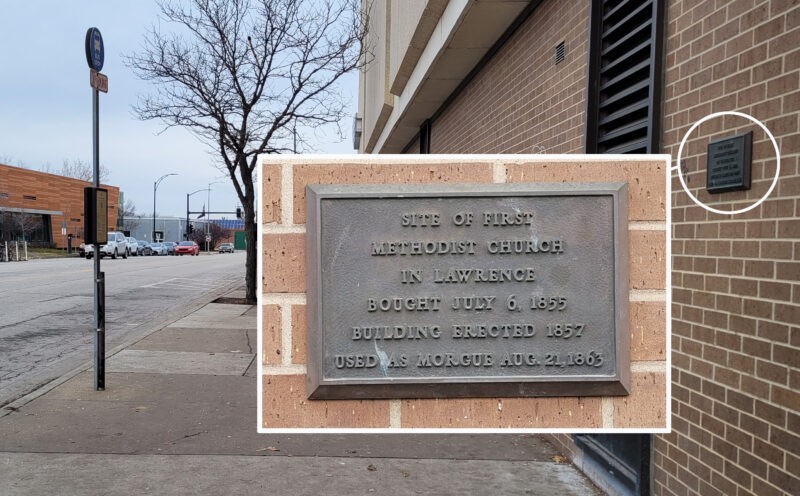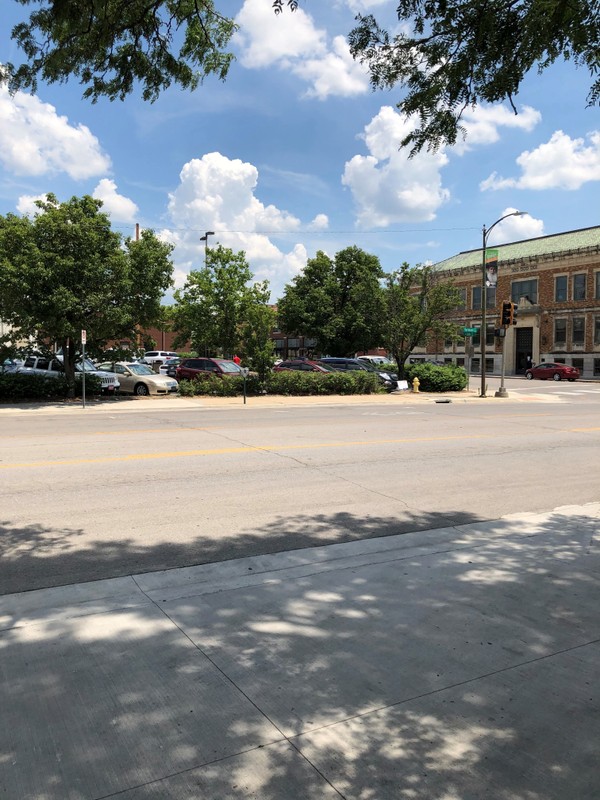The Methodist Church Historical Marker
Introduction
Text-to-speech Audio
A small bronze plaque located at 724 Vermont Street (on a wall adjacent to the bus stop) marks the original location of the First United Methodist Church. The church doubled as a morgue and triage camp after "Quantrill's Raid" on August 21, 1863. The church was one of the few structures spared during the raid. In addition to destroying most of Lawrence's structures by fire, General William Quantrill and 400 bushwhacker troops killed at least 150 men and teenage boys. The church building lasted until the 1940s while the congregation moved to a new brick church in 1865 and then to their present location on Vermont Street in 1891.
Images
The former site of the First Methodist Church and the historic plaque noting the church's role during Quantrill's Raid.


Backstory and Context
Text-to-speech Audio
In 1861, the Confederacy commissioned William Quantril as an officer under the Partisan Ranger Act which authorized the formation of guerrilla military groups. Quantrill and his men soon set their sights on attacking Lawrence. The town's founders were members of the New England Emigrant Aid Society, whose mission included actively blocking the westward advancement of slavery. Moreover, Lawrence harbored fugitive slaves, welcomed freed slaves, and played an active role in enlisting Black troops. Lastly, Lawrence was the home of James Lane an eventual U.S. Senator who led "Jayhawkers" that burned and looted Osceola, Missouri, and other nearby towns. So, at 5 a.m. on August 21, 1863, after months of planning, Quantrill and his guerrilla troops stormed into Lawrence. In a span of four hours, they killed at least 150 men and teenage boys and burned much of the town to the ground.
The First United Methodist Church on Vermont Street stood as one of the few structures spared during the raid. Two circuit-riding Methodist ministers organized First United shortly after the founding of Lawrence, Kansas, in 1854. Three years later, in 1855, They constructed a church building at 724 Vermont Street. After the 1863 raid, First United served the town as a morgue and triage center.
The congregation subsequently moved to a new brick church in 1865 and then to its present location (946 Vermont St) in 1891. The historic old church building served other congregations for decades before being converted into a residence. By the 1940s, the town no longer deemed the original church structure safe nor worthy of repair. They viewed the property as significant as the structure; thus, the old church was torn down. Still, while the structure is gone, the plaque reminds onlookers that in the aftermath of Quantrill's raid, survivors transported hundreds of injured and dead bodies to the historic location.
Sources
Epps, Kristen. "Quantrill’s Raid on Lawrence" Civil War on the Western Border: The Missouri-Kansas Conflict, 1854-1865. The Kansas City Public Library. Accessed February 19, 2024. https://civilwaronthewesternborder.org/encyclopedia/quantrills-raid-lawrence
Jansen, Steve. "Local History: After Quantrill's Raid, a Lawrence church became a morgue." Lawrence Journal-World. LJWorld.com. Accessed February 18, 2024. https://www2.ljworld.com/living/columns/2024/feb/18/local-history-after-quantrills-raid-a-lawrence-church-became-a-morgue/.
Williams, Sheryl. "Quantrill’s Raid on Lawrence: Stories of Loss Destruction and Survival." University of Kansas Kenneth Spencer Research Library. Accessed February 19, 2024. https://blogs.lib.ku.edu/spencer/quantrills-raid-on-lawrence-stories-of-loss-destruction-and-survival/.
Cynthia Hernandez, Lawrence Journal-World. https://www2.ljworld.com/living/columns/2024/feb/18/local-history-after-quantrills-raid-a-lawrence-church-became-a-morgue/
